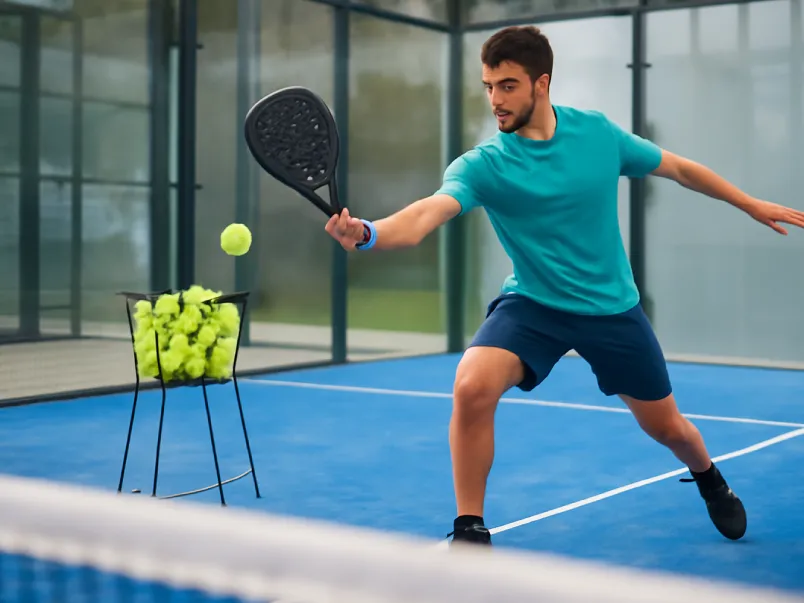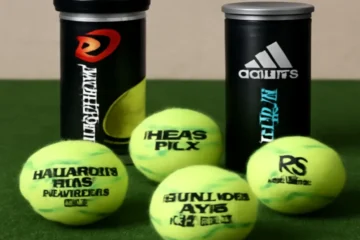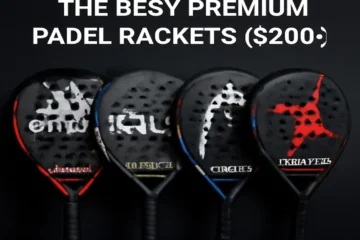Padel is a fast-growing sport that’s fun, challenging, and rewarding for players of all skill levels. Whether you’re looking to progress beyond casual games or want to take your padel skills to the next level, a structured, progressive training plan is key. In this article, we’ll guide you through a comprehensive 6-week padel training plan that will help you improve your technique, boost your physical conditioning, and refine your tactical understanding of the game. Get ready to transform from a beginner to a confident, game-ready padel player!
Introduction
Do you want to move beyond casual games and see real improvement on the padel court?
The excitement and growth of padel are undeniable, and it’s easy to see why so many players are jumping on board. However, while it’s easy to play, mastering the sport requires more than just showing up and hitting the ball back and forth. Many players hit a plateau because they lack a structured training regimen. They play, but without purpose or a roadmap for progress.
The solution? This 6-week padel training plan, designed to take your skills to the next level. Whether you’re a beginner looking to build a strong foundation or an intermediate player aiming for more consistency, this plan will help you grow across three core areas: technique, tactics, and physical conditioning.
Throughout the 6 weeks, you’ll commit to 3-4 days of training per week, focusing on drills, match play, and conditioning, all while progressively increasing the intensity and complexity of your workouts.
Part 1: The Philosophy of the 6-Week Plan
The Progressive Overload Principle
To improve at padel, just like in any sport, the key is gradual improvement. The concept of progressive overload is central to this training plan. It means that your workouts will increase in intensity, volume, or complexity over time, ensuring that your body and mind continuously adapt. You’ll start with the basics and gradually move toward more advanced concepts, helping you avoid burnout or injury.
The Three Pillars of Padel
This 6-week plan focuses on three main areas: Technical Skills, Tactical Intelligence, and Physical Conditioning. Let’s break them down:
- Technical Skills: These are the fundamental shots, grips, and movements that form the foundation of your game. From mastering the forehand to perfecting the volley, this plan will help you become more confident and consistent in your shot-making.
- Tactical Intelligence: This involves understanding when and why to use specific shots in a match. You’ll learn how to read your opponents, control the pace of the game, and create opportunities to win points.
- Physical Conditioning: Padel requires explosive movements, endurance, and agility. By focusing on specific fitness training, you’ll be prepared to handle long rallies, quick direction changes, and powerful shots.
How to Use This Plan
This plan is designed for players of all levels. Whether you’re a beginner or an intermediate player, the key is to stay consistent with your training. For beginners, focus more on technical skills and general fitness. For intermediate players, emphasize refining your shot selection and improving your tactical awareness. Consistency over intensity is what will lead to long-term improvement.
Part 2: The Training Week Blueprint
A structured week of training is essential for maximizing your progress. Here’s a sample week of training, based on a 6-day training schedule with one rest day:
- Day 1: Technical & Tactical Focus (e.g., forehands, backhands, volleys, and court positioning)
- Day 2: Physical Conditioning & Match Practice (e.g., interval running, plyometric exercises, and match play)
- Day 3: Rest or Active Recovery (e.g., light stretching or a walk)
- Day 4: Technical & Tactical Focus (reinforce Day 1 lessons)
- Day 5: Conditioning & Match Practice (e.g., agility drills, explosive power, match play)
- Day 6/7: Rest or Play a Fun Match (play a relaxed game with friends or practice specific shots)
Essential Equipment Needed
Before diving into your training, you’ll need a few essentials to get started:
- Padel racket: Make sure it’s suited to your level. Beginners might prefer a more forgiving racket, while advanced players may prefer one that offers more control.
- Padel balls: Standard padel balls are designed for the sport and provide optimal bounce.
- Comfortable sports attire: Breathable clothing will keep you cool and comfortable on the court.
- A court: A padel court is essential for practice. If you don’t have one nearby, look for clubs or facilities in your area.
- A partner or wall for drills: While practicing with a partner is ideal, solo drills using a wall can also be beneficial.
Part 3: The 6-Week Progressive Plan
Week 1: Laying the Foundation
In your first week, the focus is on the basics. You’ll concentrate on mastering your grip, stance, and basic contact with the ball.
- Technical Drills: Focus on forehand and backhand volleys from the service line. Additionally, practice your underarm serve.
- Tactical Theme: Understand your position on the court. Get familiar with the difference between being at the net versus being at the baseline.
- Conditioning: Begin with base fitness exercises such as light jogging, footwork patterns (ladder drills), and core stability exercises.
Week 2: Building Consistency
Week 2 is all about consistency. Focus on mastering essential shots like the bandaja, vibora, and lob.
- Technical Drills: Work on consistency by hitting the ball from the back of the court. Practice the lob shot, which is useful for getting out of defensive positions.
- Tactical Theme: Focus on the importance of the lob and learn how to control the net.
- Conditioning: Introduce interval running (simulating point play) and lower body strength training like squats and lunges.
Week 3: Developing Weapons
This week, you’ll work on developing attacking shots that can become your “weapons” on the court, like the smash (potrero) and the bajada.
- Technical Drills: Practice overhead smashes from different positions and the bajada off the back glass.
- Tactical Theme: Understand when to attack and when to play more patiently. Learn how to create opportunities to win points.
- Conditioning: Focus on explosive power through plyometric exercises (jump squats) and agility drills that involve direction changes.
Week 4: Mastering the Net Game
Now that you’ve built your offensive arsenal, Week 4 will focus on controlling the net, including the “X3” shot (side wall play).
- Technical Drills: Work on rapid-fire volleys and drills for playing balls off the side walls.
- Tactical Theme: Learn to dominate the net with a partner. Focus on communication and movement, which are crucial when playing doubles.
- Conditioning: High-intensity interval training (HIIT) will simulate the stop-start nature of a match. Strengthen your upper body for more powerful shots.
Week 5: Tactical Sophistication
In Week 5, you’ll start learning more advanced tactics, such as shot deception and variation, with a particular focus on the drop shot.
- Technical Drills: Practice disguising your shots and work on the drop shot from mid-court.
- Tactical Theme: Focus on reading your opponents, breaking their rhythm, and combining power with finesse.
- Conditioning: Include sport-specific endurance drills like suicides and rotational core work for improved agility and stamina.
Week 6: Integration & Match Play
In the final week, it’s time to bring everything together. This is where you’ll put your technical, tactical, and physical training into action.
- Technical Drills: Multi-shot drills combining everything you’ve learned (e.g., Lob -> Smash -> Volley).
- Tactical Theme: Work on point construction and game management. Develop a pre-point routine for consistency.
- Conditioning: Complete full-court simulation drills to maintain peak fitness.
Part 4: Essential Supporting Elements
The Warm-Up (5-10 mins)
A proper warm-up is crucial for injury prevention and optimal performance. Spend 5-10 minutes doing dynamic stretches, light rallying, and mobility exercises.
The Cool-Down (5-10 mins)
Cool down after each session to aid recovery. Static stretching for key muscle groups (shoulders, legs, core) helps reduce muscle soreness.
Off-Court Conditioning
Complement your on-court training with off-court conditioning:
- Strength: Incorporate bodyweight exercises or gym workouts.
- Agility: Use ladder drills and cone drills to improve your lateral movements.
- Endurance: Incorporate running or cycling to improve cardiovascular fitness.
Part 5: Measuring Your Progress & Next Steps
How to Track Improvement
Track your progress by focusing on your consistency, reducing unforced errors, and improving shot selection. Record your wins and losses, but also pay attention to how you feel on the court and your ability to execute shots under pressure.
What to Do After 6 Weeks
After completing this 6-week plan, you should feel more confident in your skills and conditioning. Consider joining a local padel league, finding a coach for personalized feedback, or setting new goals to continue your improvement.
Final Words of Motivation
Improvement in padel, like any sport, takes time and dedication. Trust the process, stay consistent with your training, and remember to enjoy the journey. The skills you gain will not only improve your game but also your overall fitness and enjoyment of padel.
So, what are you waiting for? Start your 6-week padel journey today and watch yourself transform into a more confident, game-ready player!
FAQs
1. How long does it take to become good at padel?
Improvement in padel depends on how consistently you train. With regular practice, focusing on technical skills, tactics, and physical conditioning, you can see noticeable progress in about 6 weeks. This training plan is designed to guide you through that process, helping you develop a strong foundation and game-ready skills.
2. Can I follow the 6-week plan if I’m a complete beginner?
Absolutely! This 6-week padel training plan is designed to be adaptable for players at all levels. As a beginner, you’ll focus on mastering the basics of grip, stance, and basic shots in the first few weeks. The intensity will gradually increase, allowing you to grow at your own pace.
3. Do I need a partner to practice?
While having a partner is ideal, especially for tactical drills and match play, you can still practice solo. Many drills, such as hitting against a wall or working on your footwork, can be done alone. You can also join a padel club or find practice partners to enhance your experience.
4. What equipment do I need for the training?
You’ll need a padel racket, padel balls, comfortable sports attire, and access to a padel court. A partner or wall for solo drills is also helpful. Other equipment, like cones or ladders for footwork, can enhance your conditioning sessions.
5. How can I track my progress during the 6-week plan?
Track your progress by measuring your consistency in each shot, reduction in unforced errors, and improvement in shot selection. You can also track your fitness level, noting your ability to sustain energy and agility during matches.
6. What should I do after completing the 6-week training plan?
Once you’ve completed the plan, you can continue improving by joining a league, finding a coach for personalized feedback, or setting new goals. Continue practicing the skills you’ve developed while pushing yourself further in match play and conditioning.




